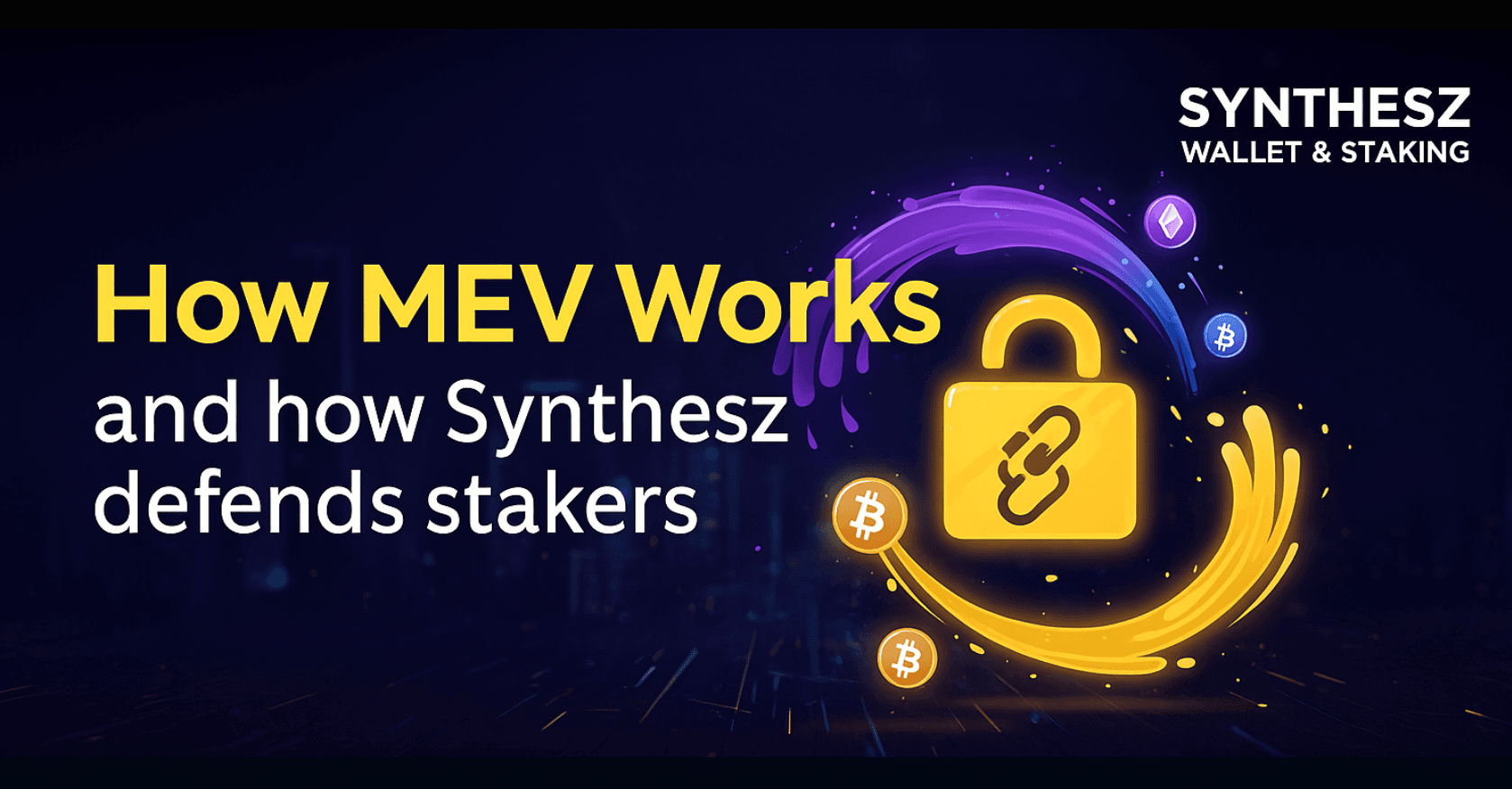
How MEV Works — and how Synthesz defends stakers
A field guide for searchers, validators, and staking clients that want clarity on maximal extractable value, today's threat models, and the safeguards we deploy.
Key takeaways
- MEV is the value block producers can capture by reordering, inserting, or censoring transactions before a block is finalized.
- Visibility into a public mempool enables strategies like sandwiching, arbitrage, and liquidations — each with distinct risk signatures.
- Well-run validators and searchers use private relays, broadcast commitments, and guard-rails to minimize harmful externalities.
- Synthesz routes staking flow through MEV-aware validators while stress-testing defensive automation inside our MEV Bot Lab.
Maximal extractable value (MEV) describes the profit that a block producer, validator, or specialized searcher can capture by influencing which transactions land in the next block and how they are ordered. The concept started as miner extractable value during proof-of-work, but the mechanics persist across modern proof-of-stake networks.
Because the public mempool exposes pending transactions, sophisticated actors monitor it in real time, predict profitable routes, and submit bundles that leapfrog normal users. Some strategies improve market health; others degrade user experience by pushing slippage, gas prices, or liquidation cascades onto the crowd.
1. Visibility starts in the mempool
Every transaction that hasn't been finalized lives temporarily in a mempool. Validators and searchers subscribe to these broadcasts, simulate outcomes, and evaluate profitability by the time it takes to include the transaction and the gas they must pay to outrank competitors.
- Token swaps with large slippage tolerances
- Cross-DEX price discrepancies that sustain post-fee profit
- DeFi positions nearing liquidation thresholds
- New NFT mints with limited supply and high resale demand
Once a strategy is identified, the searcher crafts a bundle — a sequence of transactions submitted together — that instructs the block producer to execute them atomically for a kickback.
2. Strategic reordering generates the value
The power comes from the ability to decide which transaction is first, last, or excluded. Three patterns dominate production environments today:
Sandwiching
The searcher buys before a large swap to push price up, lets the victim execute at a worse rate, then sells back down to capture the spread. It thrives on AMMs with predictable slippage curves.
Arbitrage bundles
Simultaneous buys and sells across venues realign prices. When executed responsibly, this keeps markets efficient, narrows spreads, and increases on-chain liquidity depth.
Liquidation triggers
Lending protocols offer a discount to whoever closes an underwater loan. Searchers race to do it first, recouping collateral and stabilizing solvency for the rest of the pool.
Validators are incentivized to accept these bundles when the proposed tip or bribe exceeds what they would otherwise earn from including normal transactions in a default order.
3. Mitigations keep the good, blunt the bad
The community has built countermeasures to balance profitable execution with user protection. At Synthesz we adopt safeguards at every layer:
- Private relays and bundles: Validators receive transactions through trusted channels like Flashbots or Titan to prevent copy-cat frontrunning while still participating in fair auctions.
- Inclusion lists & guard-rails: Our MEV Bot Console stress-tests strategies offline, verifying that inclusion policies refuse toxic order flow before capital is ever exposed.
- Dynamic gas policies: Automated bidding caps keep validators profitable without triggering runaway priority fees for end-users.
- Transparency reporting: We log bundle outcomes and share dashboards so stakers can audit where incremental yield originates.
Explore the Synthesz MEV Bot Console to see simulated sandwich, backrun, and liquidation telemetry before we connect external capital.
Why this matters for stakers
Delegating to MEV-aware validators directly affects your realised annual percentage rate (APR). Well-governed MEV capture can boost rewards by 30–90 basis points annually. Poorly managed capture erodes trust, attracts regulator scrutiny, and saddles users with unpredictable execution.
Synthesz curates validator partners with strong uptime, responsible MEV strategies, and published slashing histories. We combine that with on-chain proofs and internal lab validation so institutions and individual stakers can share in upside without inheriting unbounded risk.
- Review our Liquid Staking guide for yield mechanics.
- Join the staking dashboard and enable MEV-enhanced plans.
- Bookmark this article — we update mitigation patterns as the ecosystem evolves.
Frequently asked questions
What does maximal extractable value (MEV) mean?
MEV is the upper bound of value a block producer can capture by manipulating the order of transactions included in a block. It can be additive when it tightens market spreads, or harmful when it extracts value from regular users via techniques like sandwich attacks.
How do sandwich bots profit?
They submit a transaction before and after a target trade. The first leg pushes price in a favorable direction, the victim executes at a worse rate, and the bot unwinds in the second leg to pocket the spread. Gas bidding wars or private relay access guarantee their bundle lands first.
Is MEV always bad for the network?
No. Cross-venue arbitrage helps synchronize prices and liquidations stabilize lending markets. The negative effects come from toxic plus-EV strategies that tax normal users, increase gas spikes, or destabilize block production incentives.
How does Synthesz reduce MEV risk for stakers?
We delegate to validators that participate in trusted relay markets, enforce inclusion lists for public bundles, and simulate every playbook in our MEV Bot Console before connecting external liquidity. This keeps staking rewards attractive without exposing capital to unvetted flows.
Put MEV insights into practice
Our roadmap blends transparent validator reporting, live MEV telemetry, and secure staking flows. When you're ready, the dashboard guides you through delegations that benefit from this research.